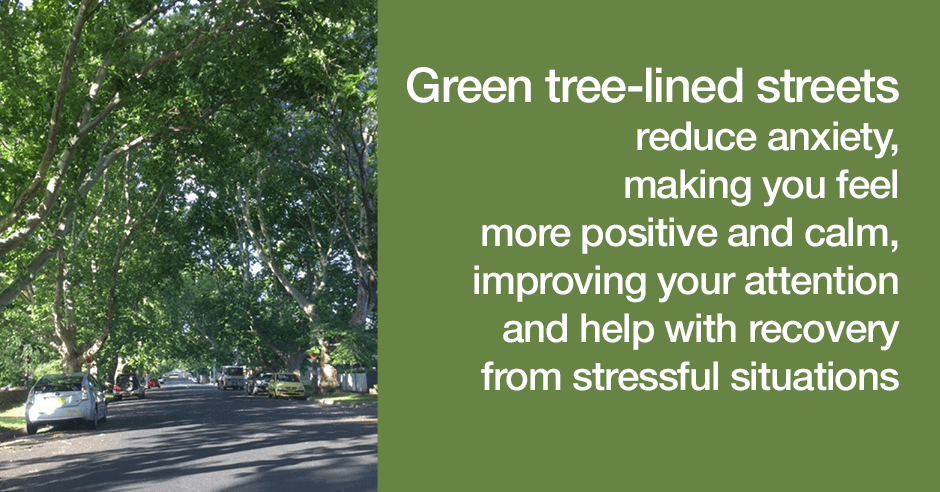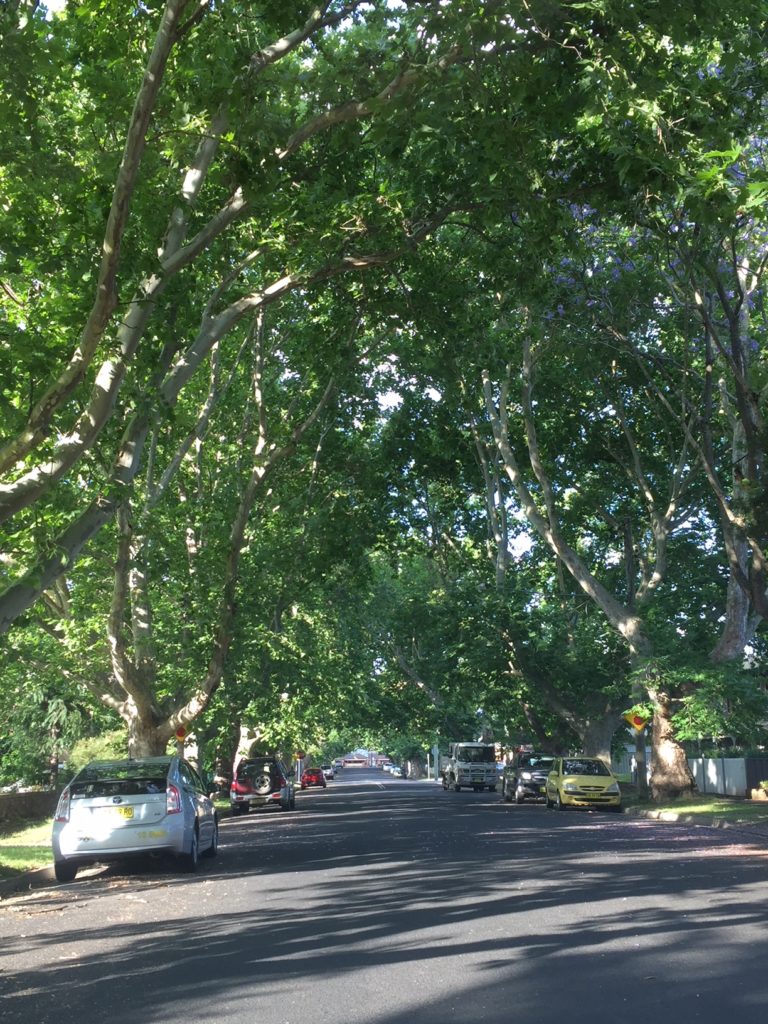
I’m a nature-lover and don’t need to be told that seeing trees or walking under them or driving along a tree-lined street has research supporting their benefits. I just feel the sense of wonderment, the calming effects and a heightened sense of joy and pleasure as soon as I’m in amongst trees in a street like the one above.
This is a quiet side street in the small town of Richmond in NSW, Australia. It runs perpendicular to a really busy road that heads up to North Richmond and beyond. Now the traffic doesn’t come close to comparing with Los Angeles traffic but for a small town it can be rather hectic from 4pm. If we happen to be heading towards North Richmond, we always take a detour along this wonderful tree-lined road and other similar tree-lined roads to get to where we’re going. As well as avoiding the bumper to bumper traffic we get this sense of ahhhhh!
I mentioned that I don’t need to be told there is research supporting the calming effects of tree lined-roads. But you know me: I’m always curious about the science so when I heard there was research I was of course intrigued about it and wanted to understand why they make us feel so good.
Here is some of the research I found: In Benefits of nature: what we are learning about why people respond to nature we discover that in general we respond in a positive way to nature and to trees in particular, especially “trees with spreading forms” reminiscent of trees on the African savanna. I was born in Africa and spent 32 years there so I find this so interesting! This paper also reports that
all colors were calming, but bright green trees were more calming than other tree colors, including less bright greens and oranges
and that
Adult responses to plants are also influenced by their childhood interactions with nature. We have shown that the more interaction people have with nature as children, the more positive are their attitudes towards nature as adults.
In this study: Stress recovery during exposure to natural and urban environments, the 120 participants were exposed to “color/sound videotapes of one of six different natural and urban settings” after watching a stressful movie. Watching the natural settings had a measurable impact on parasympathetic measures such as heart rate and muscle tension and they felt more positive, experienced improved attention and had better stress recovery.
In another study The View From the Road: Implications for Stress Recovery and Immunization, drivers were presented with a stress-causing stimulus and their reactions measured as they recovered from the stress. The Safe Streets report from the University of Washington summarizes the outcome:
Those viewing built-up, strip-mall-style roadside environments in a simulated drive after the stressful experience showed a slower and physiologically incomplete recovery and reported more negative feelings. Study participants seeing more natural roadside scenes (forests or golf courses) returned to normal baseline measures faster. An “immunization effect” was also detected, as initial exposure to a natural roadside setting decreased the magnitude of response to a subsequent stressful task.
And finally, the research about forest-bathing (known as Shinrin-yoku), although not directly related to stress-reduction from driving along tree-lined streets is worth mentioning. Just the word “forest-bathing” makes me smile.
Research on forest-bathing shows how spending time in forests can lower high blood pressure, and help ease modern-day “stress-state” and “technostress”. In one study, Effects of Short Forest Bathing Program on Autonomic Nervous System Activity and Mood States in Middle-Aged and Elderly Individuals:
The Profile of Mood States negative mood subscale scores of “tension-anxiety”, “anger-hostility”, “fatigue-inertia”, “depression-dejection”, and “confusion-bewilderment” were significantly lower, whereas the positive mood subscale score of “vigor-activity” was higher.
In summary, in this study, the 128 middle-aged and elderly individuals spent only 2 hours in a forest setting and felt less tense, had reduced anxiety, experienced less anger and hostility, felt less fatigued, were not depressed or dejected, felt less confused/bewildered and had more vigor and energy. This was after only 2 hours of forest-bathing!
Here are some ways you can get the most out of this information for your own sense of calm:
- Take a detour like we do if at all possible and enjoy the calming effects of driving along a tree-lined street. Better yet, take a moment to get out the car and soak in the beauty while walking down the road. And best of all, take a full-day hike on a weekend or go camping for 2 days.
- Plant a tree (or more than one) outside your home or get involved with a tree-planting committee at your child’s or your grand-child’s school or place of work to do the same
- Talk to your local mayor and council members to make tree planting in your community a priority
- If you live in a built-up city and can’t do any of the above, make an effort to spend quiet time in a nearby park
- Find a tree-planting charity that is a good fit and make a donation in the name of a loved one in lieu of a gift or just do it for yourself
- If you’re housebound (with agoraphobia for some other reason), find some pictures or a poster of green trees or dig out some old photos. Just looking at pictures of nature and greenery have a stress reducing effect.
On that note here is the bigger version of my Richmond tree-lined street image so you can enjoy looking at it while reading this blog AND get some of the stress-reducing benefits…until you’re in your own tree-lined street or out in nature.

I hope this motivates and inspires you to drive down more tree-lined streets and to do something tree-related in your life in addition to all the nutritional changes you’re making to eliminate your anxiety!
We’d love to hear how much you love trees and the outdoors. Do you have a favorite tree-planting charity? Feel free to share your feedback and questions too.
I attended one of your CE workshops and still love following your blog. I love this graphic and your creative ways to use greenery for calm. May I use your graphic in a short article on blog with a link to this article on your blog?
Hi Di
Thanks for your kind words – wow I was in Wisconsin teaching so many years ago – it’s wonderful that you’re still following my blog! I’m so glad you love this graphic and my tips! I’m more than happy for you to use it with a ink back to this blog. Please do share your link here
May I ask if you’re incorporating nutrition and nutrients like the amino acids and others in your work?
To an extent.. I am incorporating nutrition and many concepts from your training and your book (and often recommend your book!) however I never got into the amino acid testing. Honestly, I think this is due to my own lack of confidence including a little uncertainty on part as to whether that would be considered within the scope of practice of my LPC license without some sort of nutrition degree or license.
Di
So glad to hear you’re incorporating nutrition and many concepts from my training and book (thanks too for recommending it). For LPCs there are a few options: teaming up with a nutritionist (either in the same office or referring out); studying to be become a nutritionist yourself; and checking with your licensing body about what you can and can’t do in terms of scope of practice.
With regards to lack of confidence in recommending the amino acids I would expect that as the 1 day PESI training was a very high-level overview of all the nutritional approaches to consider, and just highlighting the amino acids. Last year September I launched a more in-depth training purely on the amino acids and will be relaunching it again shortly.
Hi Trudi,
A splendid article I read with interest as I drive down those same tree lined streets.
Elaine
So glad you find it splendid (what a lovely word!) and enjoy those tree-lined streets!
I’ve been “grooving” with trees since childhood. Growing up in Oklahoma, there were few large trees. The “post oak” is a short oak tree that was quite common. Since my childhood, the numerous man-made lakes changed the environment there, and now it is much more heavily wooded. I would stand under a large tree at the park, in the rain, and become what I’d call ecstatic, just staring at the leaves and branches, the trunk, the bark. I moved to the northern California coast where I’ve lived with Redwoods now for decades. One area of my research is the world of mushrooms. It’s thrilling to understand how the underground mycelium interacts with the roots of trees, communicating, assisting each other. Learning much more about our guts and the relationship to soil, I really get why I feel so good outside, near trees, near the ocean, close to earth. My favorite tree planting company is Trees For A Change.
Suzanna
Thanks for sharing and telling us about Trees For A Change. I love that you become “ecstatic, just staring at the leaves and branches, the trunk, the bark”! I lived in California and also love the Redwoods. I know nothing about mushrooms and tree roots – please do enlighten us.